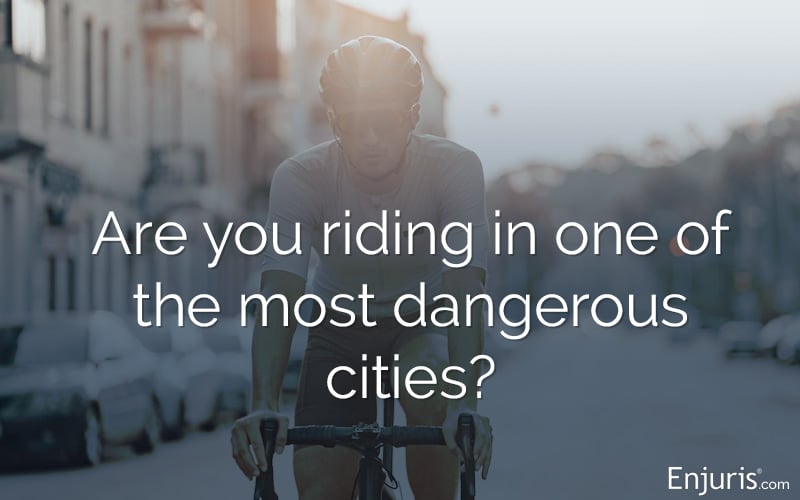
Bicycling has evolved from being merely an occasional recreational activity to a preferred mode of transportation, a method for maintaining fitness, and a significant lifestyle choice for many.
In 2010, approximately 42 million Americans were active cyclists. Fast forward to the present, and the latest data from Statista reveals that this figure has soared to over 51 million.
With the growth in cycling's popularity, particularly in congested urban areas, the risks and challenges have also become more pronounced. This post aims to guide our readers, especially the bicyclists among us, about the most perilous places to pedal and what can be done to enhance safety.
Why do bicycle accidents happen?
Bicycle accidents occur for various reasons, ranging from environmental factors to human errors. According to the National Highway Traffic Safety Administration (NHTSA), failing to yield the right of way is the highest factor in fatal bike crashes, followed by bicyclists not being visible.
Other common factors include:
- Poor road conditions
- Busy intersections
- Motor vehicle driver error
- Cyclist error
- Intoxication
- Animals on the road
Criteria for ranking the most dangerous cities for cyclists
Our insights derive from the NHTSA’s most recent report. We've considered cities with 500,000 or more residents and focused on the fatality rate per 100,000 people. This approach provides a data-driven perspective, emphasizing the sheer risk of fatality that bicyclists face in certain urban landscapes.
Five most dangerous cities for bicyclists
- Tucson, Arizona (1.29): Tucson tops the list, with a startling fatality rate of 1.29 cyclist fatalities per 100,000 people. According to the League of American Bicyclists, Arizona has poor bicycle infrastructure, and the state spends very little on biking and walking per capita.
- Indianapolis, Indiana (0.68): Known for its motor racing, Indianapolis might need to race towards better cycling safety, with its high fatality rate. Cyclists made up 4.2 percent of all road fatalities in Indianapolis in 2021.
- Jacksonville, Florida (0.63): Although the sunny weather makes Jacksonville a great place to ride, the roads can be perilous for cyclists. Beach Boulevard and Southside Boulevard are two of the most congested roads in Jacksonville, and accidents are common at this intersection.
- Phoenix, Arizona (0.62): Arizona's capital is another hotspot for cycling accidents. Phoenix has been one of the most dangerous places for cyclists for years, and city officials appear to finally be taking steps to rectify the problem.
- Fresno, California (0.5): Fresno concludes our list with a fatality rate of 0.5 cyclists per 100,000 people. The roads around Woodward Park, the city's only regional park, have been the scene of multiple fatal accidents involving cyclists and pedestrians.
Among the major cities with reported cyclist fatalities, New York (0.09), Denver (0.14), and Detroit (0.16) distinguished themselves with the lowest fatality rates, reflecting perhaps a greater emphasis on safety measures or other favorable conditions for cyclists.
In February 2023, 26-year-old Pedro Quintana-Lujan crashed his Ford F-250 into a group of 20 cyclists in a suburb of Phoenix, Arizona.
According to police, Pedro was driving over the Cotton Lane Bridge when he hit a barrier wall and then plowed into the cyclists.
Nineteen cyclists were injured in the crash, two of whom died.
Pedro was arrested and charged with two counts of manslaughter, three counts of aggravated assault, 18 counts of endangerment, and two counts of causing serious injury or death by a moving violation.
Possible solutions
Addressing the dangers faced by bicyclists requires a multifaceted approach. Investing in infrastructure is a key starting point. By creating dedicated bike lanes and designing intersections that are more cyclist-friendly, the risk of accidents can be mitigated.
Curious how much your state invests in bicycling infrastructure? The League of American Bicyclists publishes yearly rankings.
Alongside infrastructure, legislation and enforcement have crucial roles to play. Laws that protect cyclists, such as Idaho stops, which allow bicyclists to get out of dangerous intersections more quickly, and California’s three-feet law, which requires motorists to give at least three feet of clearance when passing people riding bikes, need not only to be enacted but actively enforced to hold motorists accountable.
Education and awareness must also be part of the solution. Ensuring that both cyclists and motorists understand how to share the road safely, and respect each other's rights, will foster a safer environment for all.
Finally, community advocacy can make a tangible difference. When local communities push for cycling safety and support necessary changes, it creates momentum that can lead to lasting improvements in urban cycling conditions.
Are you an urban biker? Here are six traffic rules and regulations to follow.
Cycling should be one of life’s great joys, not one of life’s great risks. The cities referenced in this blog post represent areas where attention, investment, and advocacy are needed most. The roads should be shared, and the responsibility lies with all of us. If you or someone you know has been involved in a cycling accident, legal remedies may be available to pursue justice and compensation.
